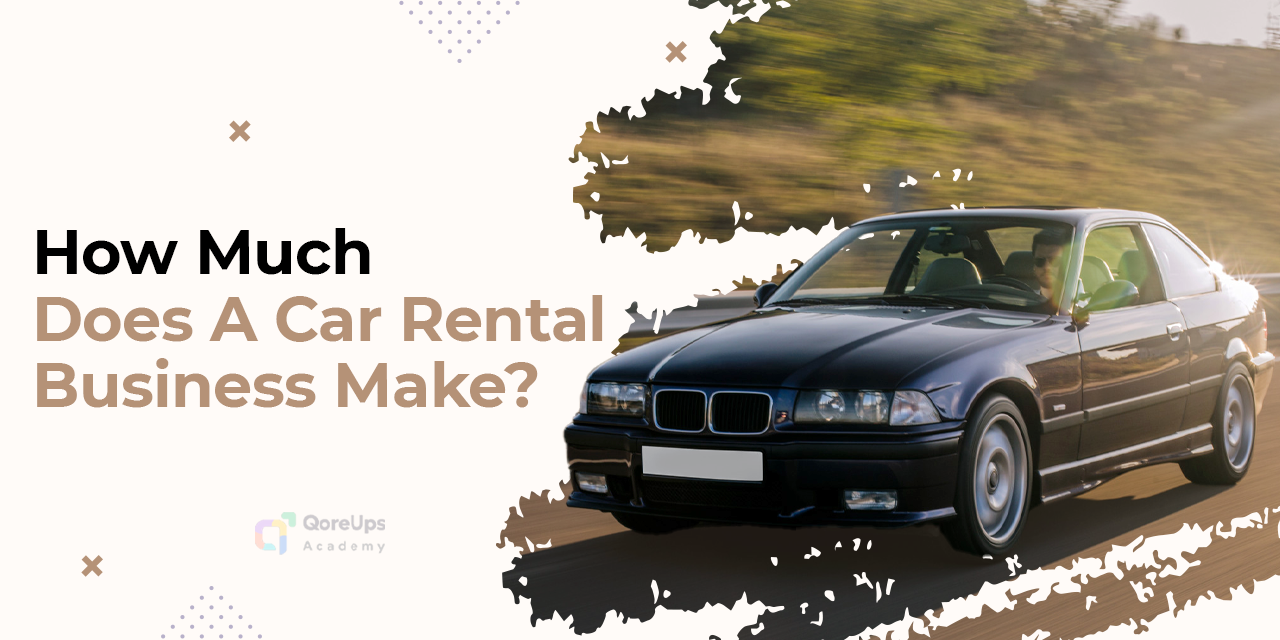Starting a car rental business is a lucrative venture for entrepreneurs looking to tap into the growing travel and tourism industry in 2025.
With the global rise in demand for travel and mobility services, the car rental sector has become a pivotal player in providing convenience to both business and leisure travelers.
If you’re considering entering the car rental business understanding the financial aspects is important.
There comes the question of how much a car rental business makes.
Thus, this comprehensive guide will cover key factors such as the car rental business’s market trends, profitability, startup costs, and revenue potential.
Car Rental Business – Overview
The car rental industry offers a wide range of services, from short-term vehicle rentals for tourists to long-term rentals for business professionals.
Rental agencies typically provide vehicles on a daily, weekly, or monthly basis.
These services are often essential for tourists, business travelers, or people whose cars are being serviced.
The car rental market offers a wide range of rental options, including:
- Economy cars: These are usually smaller and more budget-friendly options.
- Luxury cars: Higher-end vehicles that cater to clients looking for premium services.
- SUVs and trucks: Vehicles designed for travelers needing extra space or going off-road.
- Specialty cars: Including convertibles, sports cars, and other niche options.
This industry has evolved with technology, incorporating online booking platforms and offering convenience for customers to rent cars with minimal hassle.
Major international players like Hertz, Enterprise, and Avis dominate the market, but there’s also significant opportunity for smaller, regional businesses to thrive.
Market Trends of Car Rental Business
The car rental industry is currently experiencing rapid growth, influenced by several trends in the global economy and the transportation sector.
A report by Grand View Research indicates that the global car rental market was valued at USD 92.92 billion in 2022 and is projected to expand at a CAGR of 8.1% from 2023 to 2030.
Several factors are driving this growth:
- Post-Pandemic Travel Boom: With restrictions lifted, travel demand is skyrocketing. The revival in travel has driven up demand for rental cars, particularly in popular tourist areas.
- Rise in Car-Sharing and Mobility Solutions: Platforms like Turo and Getaround have revolutionized the car rental landscape, making it easier for individuals to rent out their vehicles, and creating a more flexible car rental model.
- Increased Fleet Management: Many car rental companies are upgrading their fleets with fuel-efficient, electric, and hybrid cars to cater to environmentally conscious consumers.
- Technology Integration: The integration of mobile apps, GPS, and contactless rentals has made the process smoother for both customers and businesses.
In 2023, the North American market held the largest share, accounting for more than 30% of the global market, followed by Europe and the Asia Pacific regions.
This highlights the significant demand for car rentals in developed markets, driven by high levels of tourism and business activity.

How Profitable Is Starting A Car Rental Business?
Profitability in the car rental business depends on several factors, including the size of the fleet, market location, pricing strategy, and the type of vehicles offered.
However, the potential for profitability in this industry is substantial, with rental companies able to generate steady income through daily, weekly, or monthly rentals.
The profit margins for car rental businesses can vary, but on average, car rental companies operate with profit margins of 10% to 15%.
A fleet of well-maintained cars, priced competitively, can see a solid return on investment (ROI).
For instance, an individual car can make between $30 to $80 per day, depending on the type of vehicle, location, and time of year.
Let’s see the key factors that affect profitability.
Location
Location is one of the most significant factors influencing the success of a car rental business.
Being close to airports, train stations, tourist attractions, or business districts can result in a steady stream of customers.
Car rental businesses near major tourist destinations or business hubs can charge higher rates, improving profit margins.
Fleet Size and Management
Larger fleets can serve more customers, but they also require more significant upfront investments and maintenance.
Having a mix of vehicles (e.g., luxury cars, economy cars, and SUVs) allows a business to cater to a broader market, thereby increasing profitability.
Pricing Strategy
Competitive pricing strategies can increase demand. Offering discounts, promotions, or loyalty programs can attract repeat customers, contributing to higher revenue over time.
Fleet Utilization Rate
How often your vehicles are rented out determines profitability. Maintaining a high fleet utilization rate is crucial for maximizing revenue.
Companies with excellent customer service, efficient operations, and a solid marketing strategy tend to keep their vehicles rented more consistently.

Car Rental Business – Startup Costs
Starting a car rental business requires significant capital investment to purchase or lease a fleet of vehicles, secure a physical location, and set up operational systems.
Cost To Start A Car Rental Business
The total startup costs for a small to medium-sized car rental business range from approximately $210,000 to $560,000.
This estimate includes:
- Vehicles: $150,000 – $500,000
- Insurance: $10,000 – $20,000 per year
- Office or Rental Location: $24,000 – $120,000 per year
- Licensing and Permits: $1,000 – $5,000
- Marketing and Advertising: $2,000 – $5,000
- Staffing: $30,000 – $100,000+ per employee annually
- Miscellaneous Costs: $10,000 – $20,000 in the initial year
- Car Rental Software: $1,200 – $6,000 per year (for SaaS) or $10,000 – $50,000 (for custom software)
This cost range provides a foundational investment for a small to medium-sized car rental business, with room to scale based on market demand and growth.
Below is a breakdown of the major startup costs involved in starting a car rental business.
Vehicles
The cost of purchasing or leasing vehicles is the most significant expense for a car rental business.
A single vehicle can cost between $15,000 to $50,000, depending on the make and model.
A fleet of 10 cars could cost anywhere from $150,000 to $500,000.
Insurance
Car rental businesses need comprehensive insurance to cover their fleet and liabilities.
The insurance cost can range from $10,000 to $20,000 per year, depending on the number of vehicles and the type of coverage.
Office or Rental Location
Renting a physical location, whether it’s an office space or a parking lot, can cost $2,000 to $10,000 per month depending on location and size.
High-traffic areas will demand higher rents.
Licensing and Permits
Obtaining the necessary business licenses and permits typically costs between $1,000 to $5,000 depending on the state or country.
This includes business registration and rental vehicle licensing.
Car Rental Software
Car rental software simplifies the reservation process, fleet tracking, payment processing, and customer management.
There are several options available, including SaaS platforms and custom-built solutions:
- SaaS Solutions: Many SaaS-based car rental software platforms have monthly subscription fees that range from $50 to $500 per month depending on features, which totals $1,200 to $6,000 per year.
- Custom-Built Solutions: For more tailored software, the cost of developing custom car rental management software can range between $10,000 to $50,000 as an upfront cost, depending on complexity and functionality.
Most small to medium-sized businesses start with a SaaS solution, as it is cost-effective, scalable, and includes regular updates and support.
Marketing and Advertising
To attract customers for your car rental business, you’ll need to invest in marketing.
Budgeting for online advertising, flyers, and promotions could cost $2,000 to $5,000 in the initial stages.
Staffing
Depending on the scale of your operation, you may need to hire employees to manage rentals, customer service, and fleet maintenance.
Labor costs can range from $30,000 to $100,000 annually per employee, depending on your location and staffing needs.
Miscellaneous Costs
Other expenses such as vehicle maintenance, cleaning, office equipment, and software management systems can total $10,000 to $20,000 in the first year.

How Much Does A Car Rental Business Make?
The revenue of a car rental business depends largely on the size of the fleet, location, type of vehicles, and customer demand.
However, we can provide a rough estimate based on some general calculations.
Revenue per Vehicle
The revenue generated by each car in a rental business depends on the average daily rental rate and how frequently each car is rented out (known as the utilization rate).
Daily Rental Rate
- The rental rate for each vehicle can vary based on the type of car and market demand.
- Typical daily rates for economy or standard cars range from $30 to $50. For luxury or specialty cars, the rates can go up to $100 or even $150 per day.
For the sake of this example, we’ll use an average daily rental rate of $50 per vehicle for a small to medium-sized car rental business focusing on standard cars.
Utilization Rate
- The utilization rate refers to the percentage of time each car is rented out. A car rental company with a strong customer base and effective marketing strategy can achieve a utilization rate of 60% to 80%.
- At a 60-80% utilization rate, each car would be rented out for about 18 to 24 days per month on average.
If we assume an average utilization rate of 30 days per month to keep calculations simple, the monthly revenue per car is:
50 (daily rate)×30 (days)=1,500 USD per month
Revenue for a Fleet of 10 Cars
Now, let’s consider a small rental company with a fleet of 10 vehicles. Using our previous calculation of $1,500 in revenue per car per month:
1,500 USD×10 (cars)=15,000 USD per month
This yields a gross monthly revenue of $15,000 for the fleet. The actual monthly revenue may fluctuate based on seasonal demand, location, and marketing effectiveness.
Total Annual Revenue for 10 Cars
To calculate the annual revenue, simply multiply the monthly revenue by 12 months:
$15,000 per month × 12 months = $180,000 annually.
Thus, with a fleet of 10 cars, a car rental business can generate an estimated $180,000 annually.
This calculation provides a rough idea of potential revenue, but actual revenue can vary based on several key factors:
- Higher Rental Rates: If some vehicles are luxury or specialty cars, the daily rental rate could be much higher than $50, leading to greater revenue.
- Expanded Fleet: A larger fleet increases revenue potential. If you grow from 10 cars to 20, 30, or more, the revenue will scale accordingly.
- Utilization Rate Variations: If you achieve a higher utilization rate (e.g., close to 80%), each car will bring in more revenue since it’s rented out more often.
Expansion Potential and Revenue Growth
As the business grows, so does its earning potential. For example:
Doubling the Fleet
By doubling the fleet from 10 to 20 cars, the company’s annual revenue could increase proportionally if the utilization rate and daily rates remain consistent, potentially reaching $360,000 annually.
Increasing Daily Rates
If the business invests in luxury or specialty vehicles and increases the daily rental rate to an average of $75 or $100 per day, the revenue per car would be higher.
For instance, with a $75 average daily rate, each car could generate:
75 USD×30 days=2,250 USD per month per car
With a fleet of 10 cars, that’s $22,500 per month or $270,000 annually.
Summary of Potential Earnings
In summary, here’s a range of potential earnings for a small car rental business with a 10-car fleet:
- Conservative Estimate (Average $50/day rate): $180,000 annually
- Moderate Growth (Average $75/day rate): $270,000 annually
- Expansion Potential (20 cars at $50/day): $360,000 annually
These estimates highlight the potential of a car rental business to generate substantial income, especially as it scales.

Conclusion
Starting a car rental business can be a highly profitable venture, but it requires careful planning, significant capital investment, and a clear understanding of your market.
So have a clear car rental business plan along with a revenue plan.
With the car rental industry continuing to grow due to global travel demand, technology advancements, and an increasing reliance on mobility solutions, now may be a great time to get started.
If you carefully manage your fleet, optimize pricing, and focus on customer satisfaction, a car rental business can generate substantial revenue over time.






